Workflow automation in higher education: 3 airSlate workflows for colleges and universities

The past year has demonstrated the drastic need for digital transformation and workflow automation in education. Colleges, universities, and other institutions were forced to go online which led to new challenges both for educators and students. With a focus on organizing educational processes without losing efficiency or excessive spending, more and more educational institutions are exploring the capabilities of workflow automation.
According to KMPG research, only 54% of surveyed educational institutions build their workflows on digital platforms. So, what keeps the other 46% from implementing information technology and workflow automation in their day-to-day processes, and which challenges do they have to address?
In this blog, we’ll look to answer these questions as well as explore the three most typical workflows for higher education that can be automated with airSlate in mere minutes.
Take note: airSlate offers a library of ready-to-use Flow Templates for higher education institutions. But we’ll dwell on that more a little later.
What is workflow automation in Education?
In simple terms, workflow automation is the process of automating human tasks, data, and file routing between individuals or systems.
Speaking of higher education establishments, such processes include student registration, workshop application, checklist evaluation, lesson planning, student attendance checking, student data tracking, and many others.
The table below contains the main automation functions for higher education establishments and the impact of automation on education (improving the student experience, reducing errors, increasing efficiency, etc.):
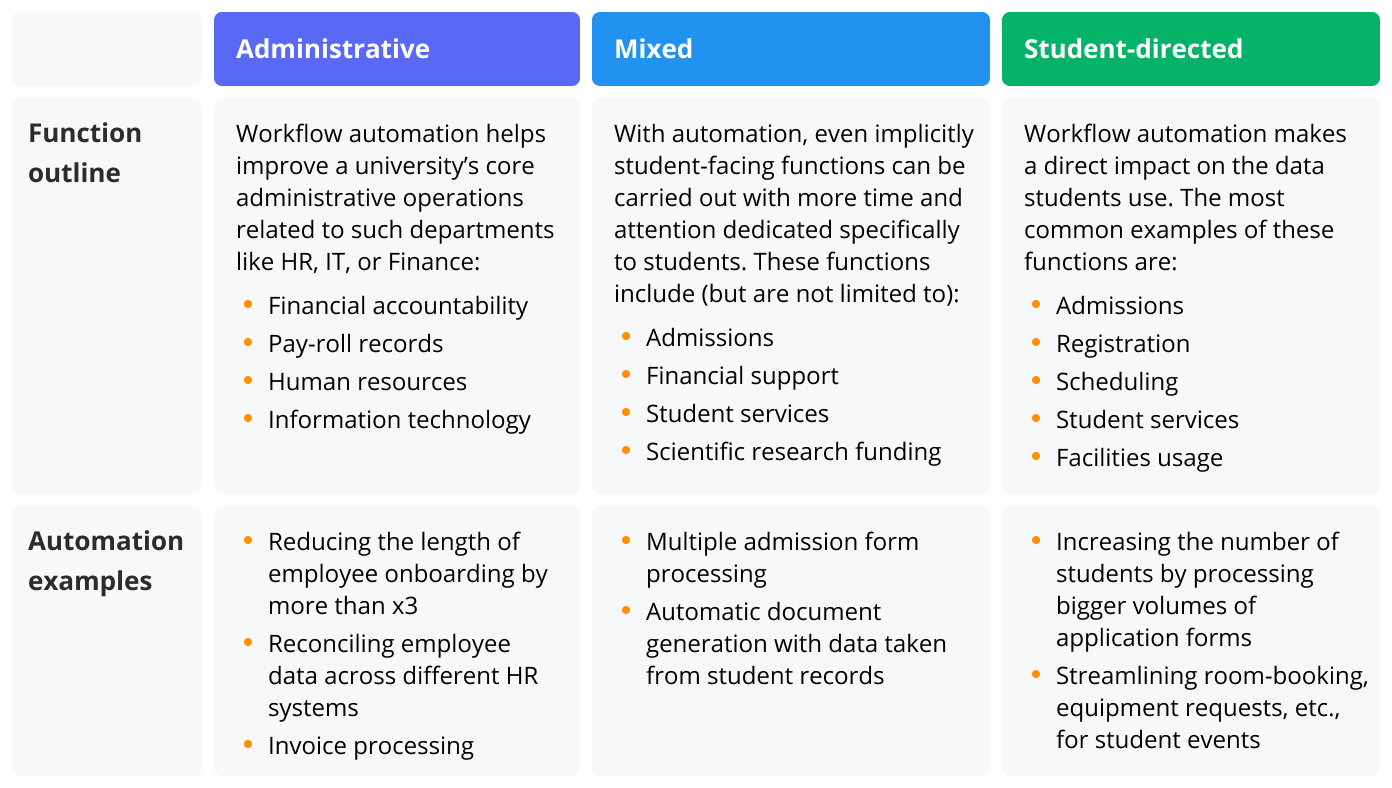
Each workflow automation solution has a set list of steps a user has to follow to automate a certain process. The level of complexity depends on whether the platform is low-code or no-code.
If you’re using a low-code solution, your educational establishment will most likely need a professional developer to set it up. In the case of no-code solutions, some organizations tend to rely on citizen developers. However, the key benefit of such platforms is that literally anyone can learn to use them, no coding skills required.
In one example, Claremont Graduate University used airSlate to streamline its adjunct contracting process. The university suffered from data errors, misplaced signatures, time loss, and additional expenses because most of its workflows were paper-based. airSlate enabled the Claremont Graduate University to create automated workflows across multiple departments and solved the establishment’s key issues by going paperless.
airSlate helps digitize and automate academic processes of any complexity. Take paper, confusion, and mistakes out of the equation and replace them with fast and simple forms for collecting more accurate data and saving time.
How to assess document workflow automation needs for colleges and universities
To derive maximum benefit from workflow automation for your institution, start by identifying:
- which processes should be automated
- how an automation system can increase a school’s efficiency
- what business process automation solution is best suited for this purpose
1. Conduct a workflow audit
Investigate and assess the structure of those workflows you’ve already been using to identify their strong and weak points.
Here are some useful questions to help you conduct an efficient workflow audit:
- Which workflows does your educational institution have in place?
- Which of them require the most paperwork?
- Which of them require the most people to sign off?
- Which automation tools are you already using? (if any)
- Which processes have been automated to a certain extent?
- What is the current state of data security within your educational institution?
2. Determine the key inefficiencies to work on
The next step is analyzing the processes that suffer from inefficiencies due to a lack of automation.
As a rule, these include:
- Manual tasks (data input and transfers, document sorting, and other routine, repeatable processes)
- Resource wastes (paper, ink, printing/scanning equipment, etc.)
- Communication challenges (reminders, notifications, scheduling, etc.)
- Educator and student satisfaction (suggestions, complaints, etc.)
3. Visualize your workflow
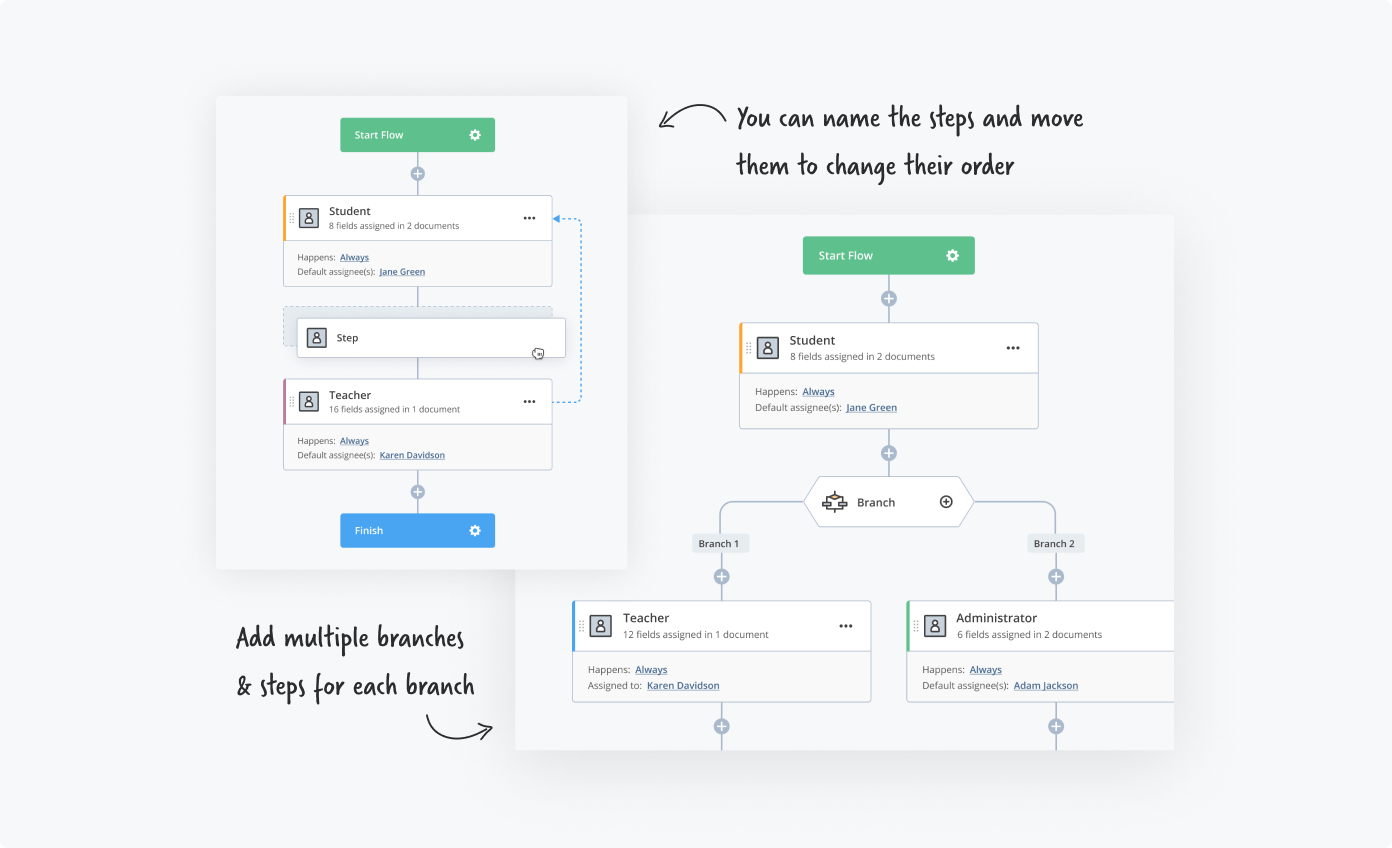
Simple though it may seem, workflow visualization is a highly useful technique. By creating a process diagram you observe:
- the parties involved
- documents included
- document routing from one party to another
- actions each party takes with those documents
- and more.
As a result, you will get a clear picture of which processes don’t require human involvement and can be automated or even eliminated.
4. Pick the right automation tool
And finally, select the automation solution that addresses the exact pains your current workflows suffer from. There are plenty of tools and techniques for automation of data sources in higher education, that’s why we advise focusing on the following key points:
- Functionality
Check whether the automation platform’s functionality fulfills the requirements of your educational establishment’s workflows. For example, if you work with external systems (cloud storage services, CRMs, etc.), the solution should support integrations with those systems.
- Required skills
Determine if the automation platform requires a certain level of programming skill (low-code) or doesn’t require coding at all (no-code). In the first case, you will need to involve professional developers, while no-code workflow automation solutions are easy for anyone to master.
- Deployment speed
This point is connected to the previous one: the simpler and more user-friendly the automation platform operating principles are, the faster it is to deploy.
- Price
‘The cheaper the better’ approach doesn’t work here. Even if the initial price is higher, you can end up paying less because there’s no need to organize special staff training, outsource to expensive developers, or buy additional tools (e.g., PDF editor, electronic signature).
3 airSlate Flow Templates for workflow automation in higher education
Here are the top 3 most popular airSlate Flow Templates for higher education:
1. Application Form for University Flow Template
Collecting and sorting applicant information is one of the biggest challenges for any educational institution that typically suffers from data loss, misplaced information, typos, and more. airSlate helps eliminate these issues with a fully automated Application Form for University Flow.
The configuration process is fast and simple:
1) Get registered with airSlate and create your Workspace.
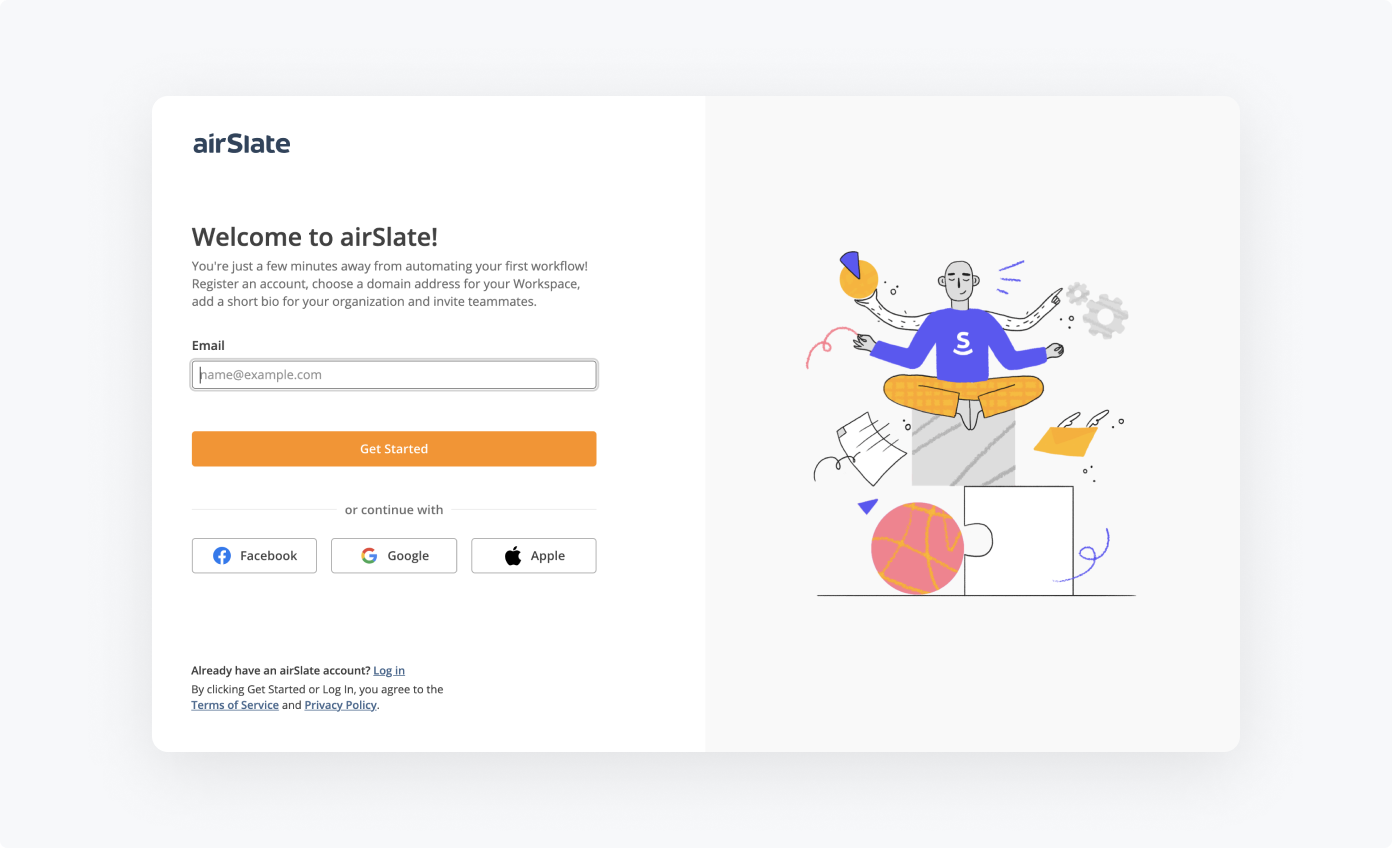
2) Select the Flow library within your Workspace, enter the workflow keywords in the search field, select the flow template, and click Import.
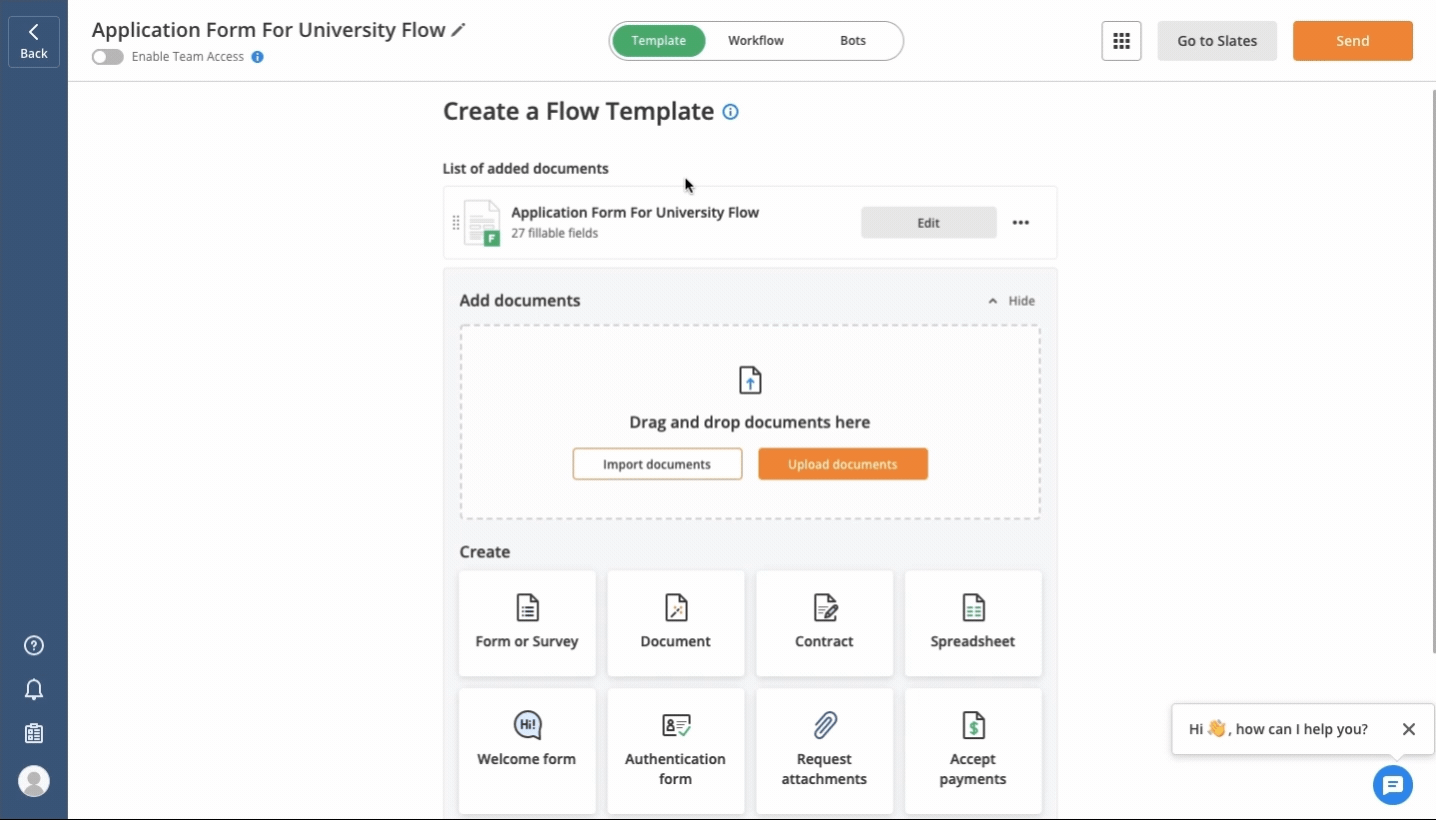
3) Edit the default form or add more documents, if needed.
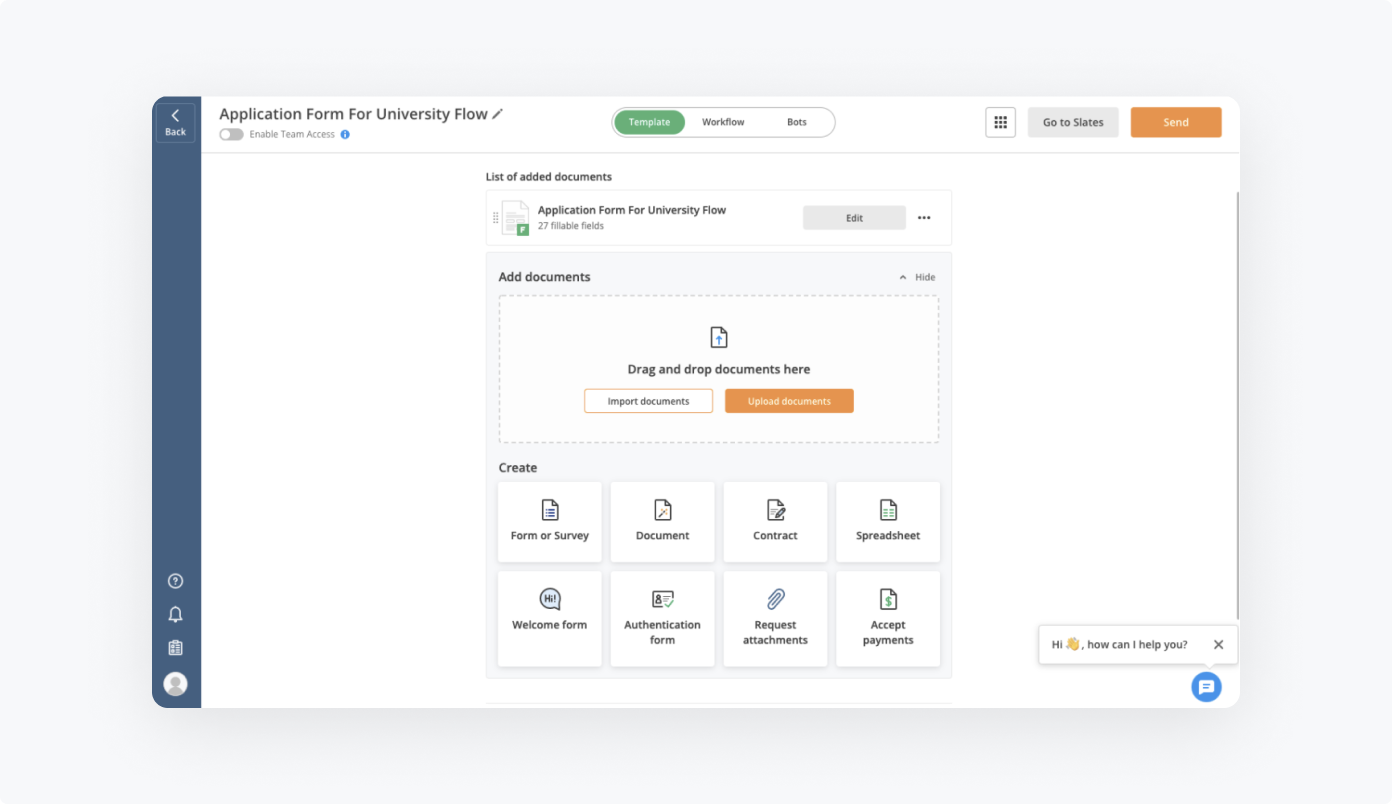
4) Visualize the process by adding workflow Steps and assigning access permissions to them.
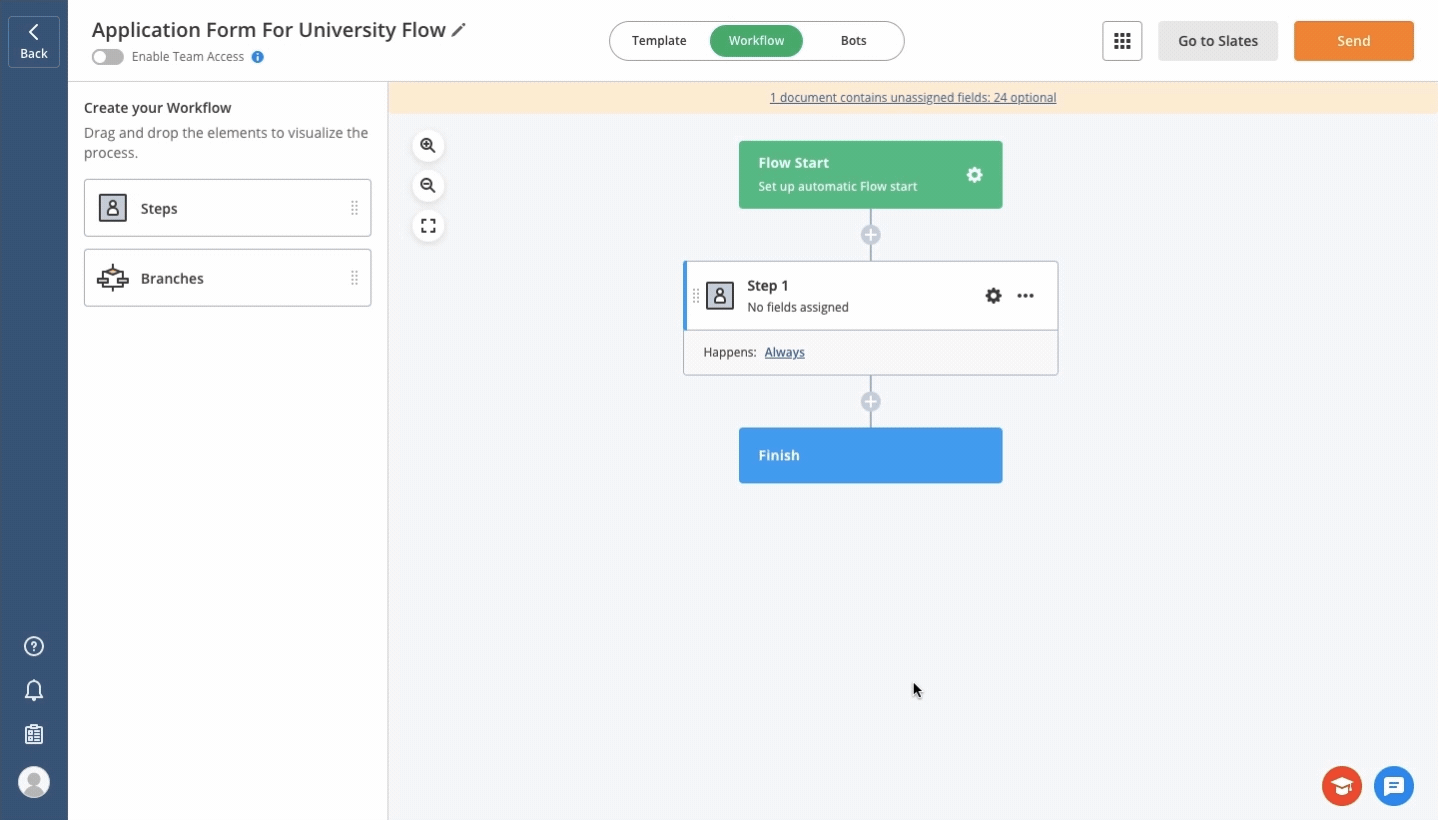
5) Install and configure airSlate Bots to automatically transfer data, send notifications, archive completed documents, and more. The Bots are no-code so their configuration doesn’t require any technical skills.
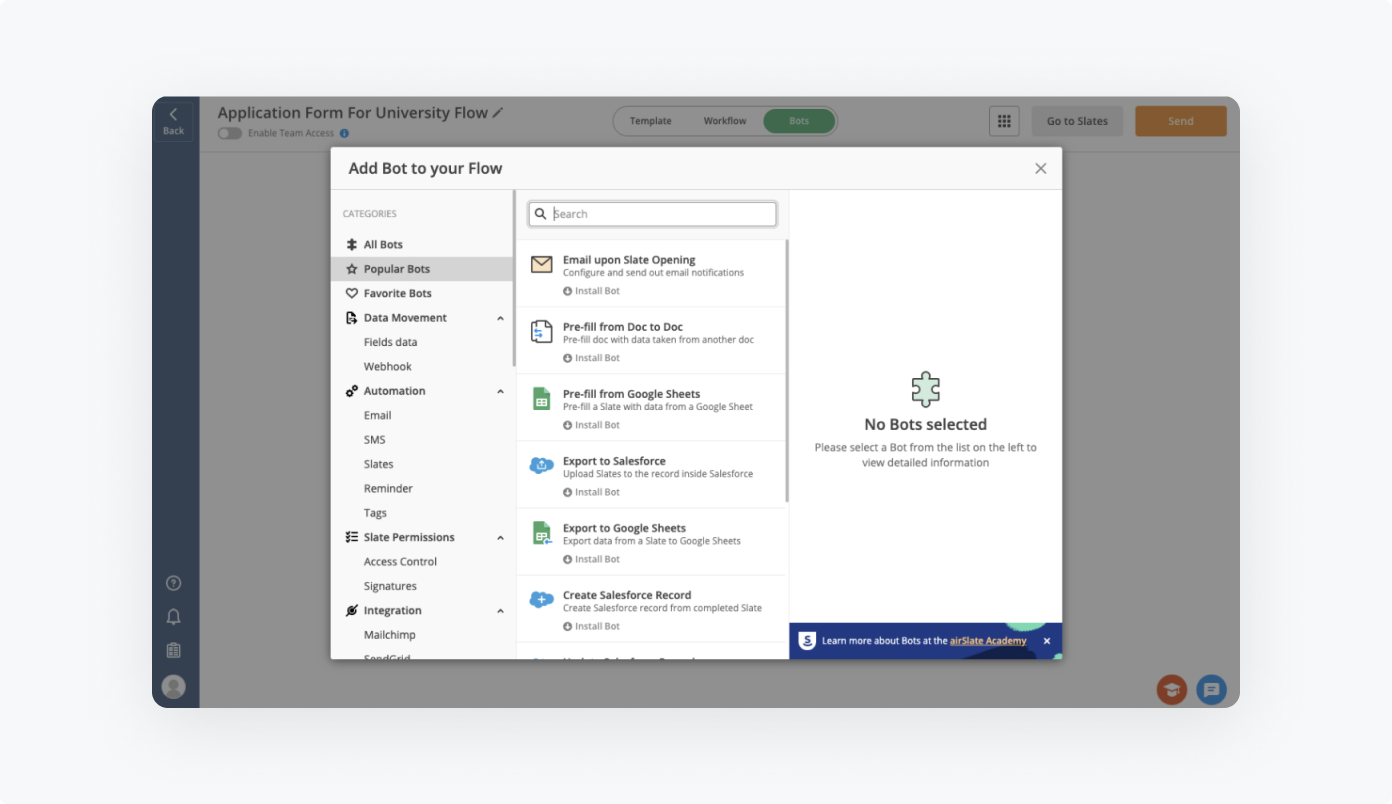
That’s it! Just click the Send button and share your flow template with the specified recipients or create a sharable link for them to access.
2. Module Registration Form Flow Template
As a rule, module registration involves tons of paperwork and collects the usual types of data: student’s name, email, degree, selected courses, and so on. Education automation with airSlate solves this issue without hassle.
The template for proceeding with automation in the classroom is very similar to that of the previous Flow.
The only difference is:
- the document to be used (you can add any document to the workflow but the default one in this flow template is a Module Registration Form):
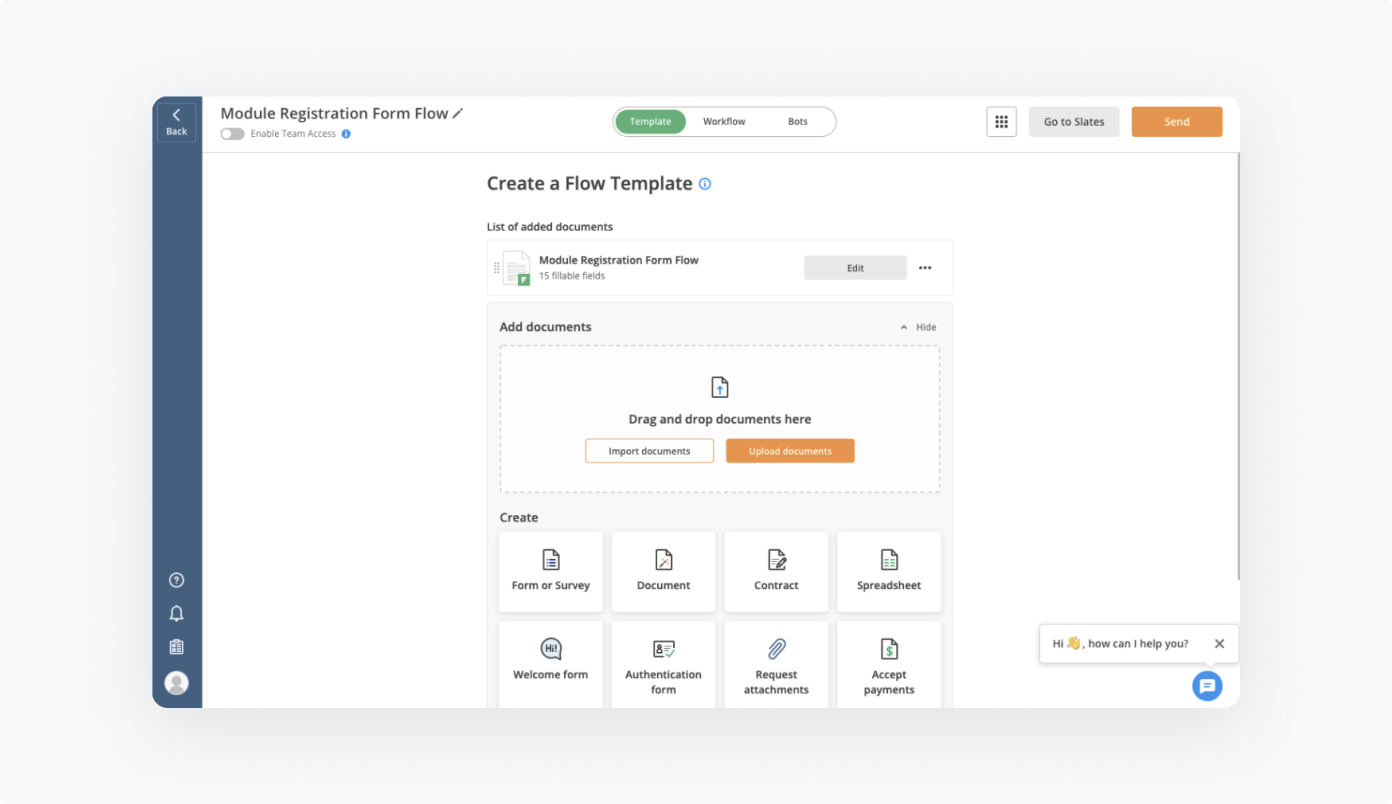
- The workflow Steps and access permissions you assign (you can add the Steps you need and assign documents to them; the most typical Steps for this flow template are Student, Teacher, and Registrar):
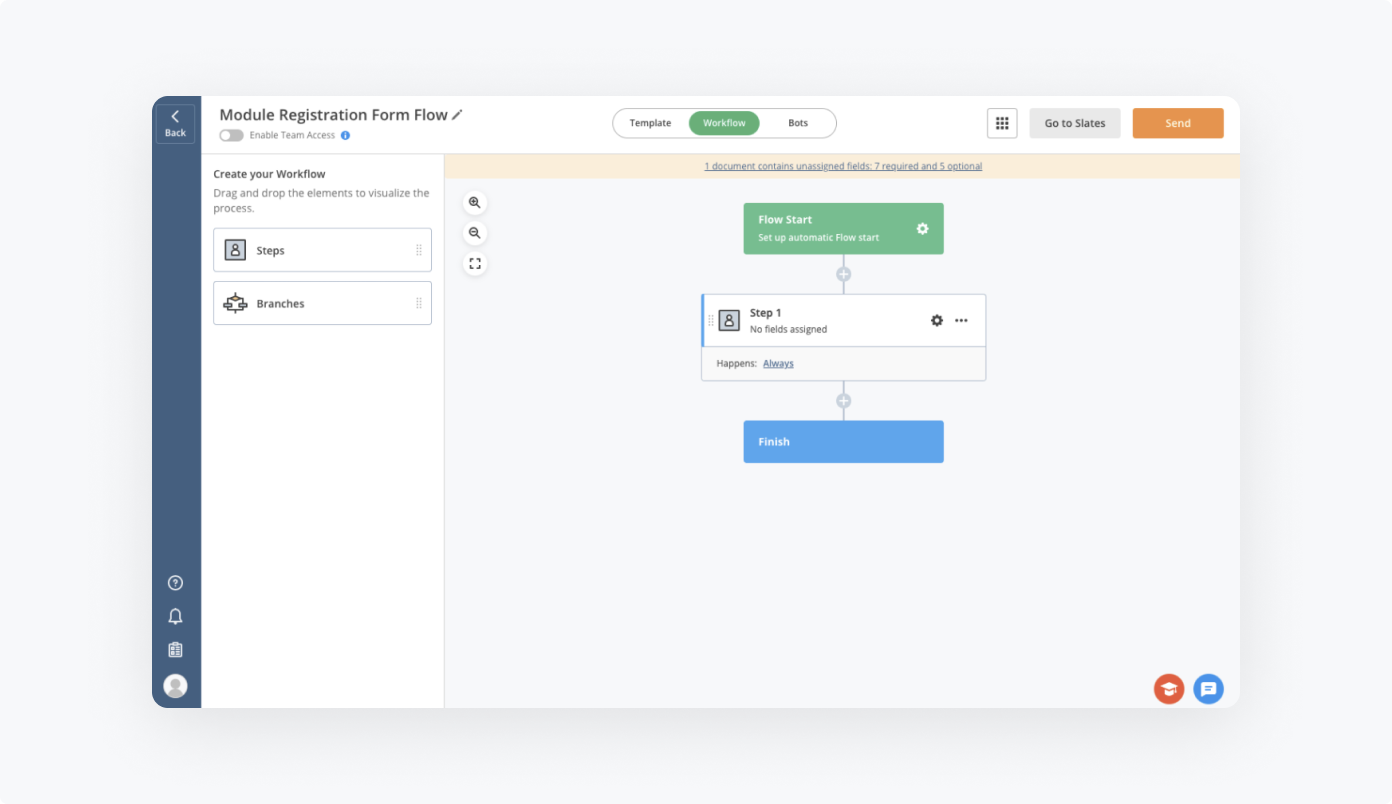
- The Bots to add (this flow template has only one Email on Documents Completion Bot added, you can choose to add more Bots if needed):
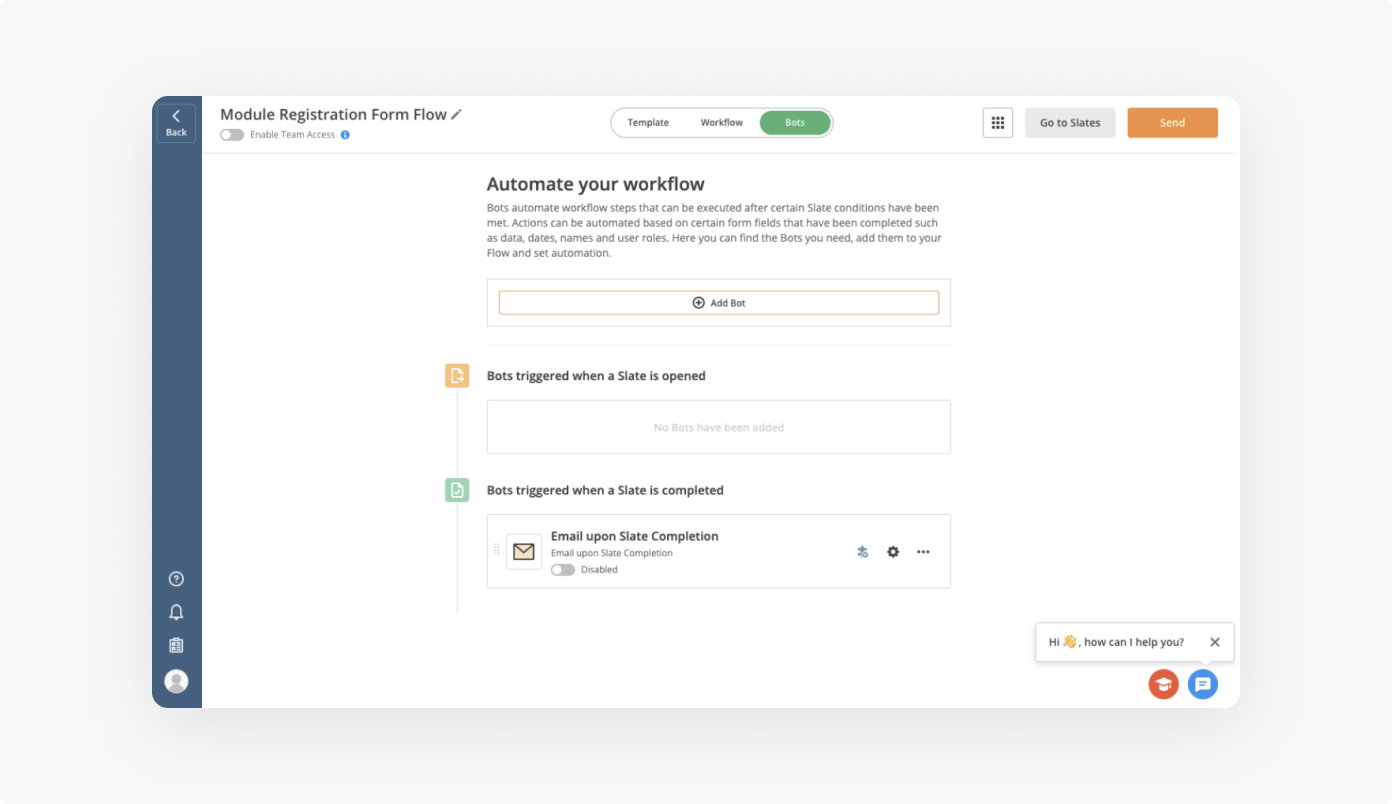
Upon configuring the Bots, you can share the Module Registration Form Flow Template just like the Application Form for University Flow Template.
3. Student Attendance Form Flow Template
Be it college, or university, student attendance checks are an integral part of the educational process. That’s why the last on our list of airSlate Flow templates for higher education is the Student Attendance Form Flow Template.
You are already familiar with the flow configuration process from the previous two examples. Follow the same pattern, just:
- add the document you need for this flow template (the default one is a Student Attendance Form)
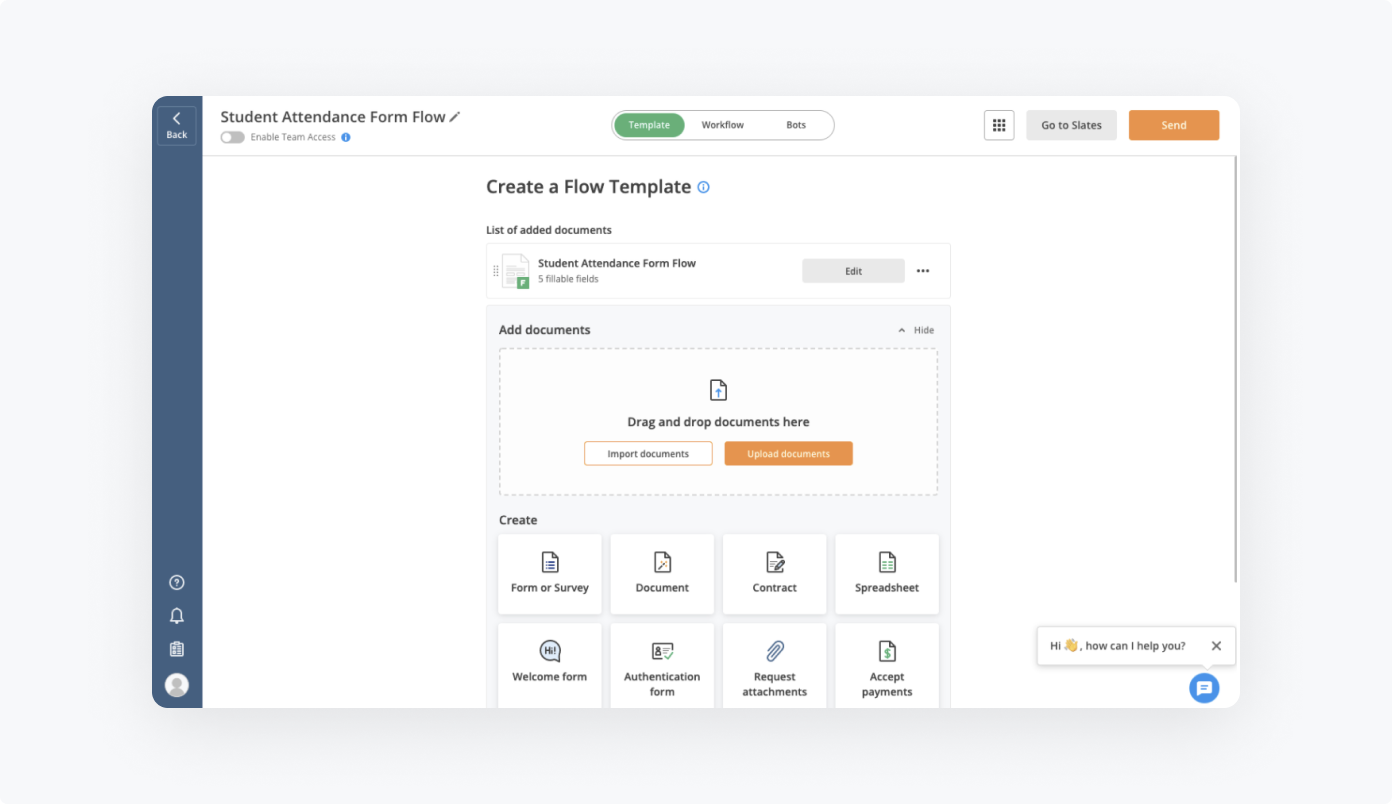
- add the necessary workflow Steps
- install and configure the Bots you need
- Share the Student Attendance Form Flow Template with recipients just like in the previous two examples.
How to learn workflow automation in higher education?
To make matters more convenient, the airSlate Academy has created a compilation of courses dedicated to workflow automation in university or other education establishments.
For example, the Student Registration course demonstrates how to streamline and simplify the process of registration for any class, course, workshop, etc.
With the airSlate Academy, you get all the necessary information for setting up automatic workflows within your educational establishment quickly, easily, and without any coding skills required.
The bottom line
Regardless of your institutions’ education, profile, or size, workflow automation is capable of addressing its most common challenges by eliminating human errors, reducing resource waste, and streamlining the process from end to end. With airSlate Academy courses, you will learn to configure these types of workflows in a matter of minutes.
Stay tuned! Our upcoming posts will provide you with more information on the most popular workflows that other industries automate.
Contact us to explore the possibilities of business automation with airSlate.
Fill out the form below to request a free demo!
- What is workflow automation in Education?
- How to assess document workflow automation needs for colleges and universities
- 3 airSlate Flow Templates for workflow automation in higher education
- 1. Application Form for University Flow Template
- 2. Module Registration Form Flow Template
- 3. Student Attendance Form Flow Template
- How to learn workflow automation in higher education?
- The bottom line

